


A leaf boat is a traditional toy made in various parts of the world using nothing but a leaf. Various types of leaves are used depending on the area, most commonly flag iris, reed leaves and bamboo leaves.



A leaf boat is a traditional toy made in various parts of the world using nothing but a leaf. Various types of leaves are used depending on the area, most commonly flag iris, reed leaves and bamboo leaves.
In most cases, the process of the more complex boats involves:
| This toy-related article is a stub. You can help Wikipedia by expanding it. |

Bamboos are evergreen perennial flowering plants in the subfamily Bambusoideae of the grass family Poaceae. The word "bamboo" comes from the Dutch or Portuguese languages, which probably borrowed it from Malay.

Glutinous rice is a type of rice grown mainly in Southeast and East Asia and the eastern parts of South Asia, which has opaque grains, very low amylose content, and is especially sticky when cooked. It is widely consumed across Asia.
Jook-sing or zuk-sing (竹升) is a Cantonese term for an overseas Chinese person who was born in a Western environment or a Chinese person who more readily or strongly identifies with Western culture than traditional Chinese culture.

Reed is a common name for several tall, grass-like plants of wetlands.

Zongzi is a traditional Chinese rice dish made of glutinous rice stuffed with different fillings and wrapped in bamboo leaves, generally of the species Indocalamus tessellatus, sometimes, with reed leaves, or other large flat leaves. They are cooked by steaming or boiling. In the Western world, they are also known as rice dumplings or sticky rice dumplings.

The Asian conical hat, commonly known as an Asian rice hat, coolie hat, oriental hat or farmer's hat, is a simple style of conical hat originating in East, South, and Southeast Asia; and notable in modern-day nations and regions of Bangladesh, Bhutan, China, Cambodia, India, Indonesia, Japan, Korea, Laos, Malaysia, Myanmar, Nepal, Philippines, parts of Russian Manchuria and Vietnam.

Sudare are screens or blinds. They are sometimes called misu as well, particularly if they have a green fabric hem. Sudare are made of horizontal slats of decorative wood, bamboo, or other natural material woven together with simple string, colored yarn, or other decorative material to make nearly solid blinds. They could be either rolled or folded up out of the way. Yoshizu, non-hanging type sudare, are made of vertical slats of common reed and used as screen.

The xiao is a Chinese vertical end-blown flute. It is generally made of bamboo. It is also sometimes called dòngxiāo, dòng meaning "hole." An ancient name for the xiāo is shùzhúdí but the name xiāo in ancient times also included the side-blown bamboo flute, dizi.

Bambusa vulgaris, common bamboo, is an open-clump type bamboo species. It is native to Indochina and to the province of Yunnan in southern China, but it has been widely cultivated in many other places and has become naturalized in several. Among bamboo species, it is one of the largest and most easily recognized.

The gogona is a type of jaw harp, a vibrating reed instrument that is used primarily in the traditional Bihu music in Assam. It is made of a piece of bamboo/horn that has a bifurcation on one end. The solid end is gripped with the teeth and the free ends are then struck repeatedly with the fingers to emit the distinctive sound of the gogona. It was originally developed in ancient China(Kouxian) and passed on to the Sino-Tibetan tribes who migrated to Assam, chiefly the Sadiyal Kacharis(Chutias, Deoris, Sonowals).

A baníg is a handwoven mat usually used in East Asia and the Philippines for sleeping and sitting. This type of mat is traditionally made in the Philippines.

Iris confusa (also known as the bamboo iris is a species of iris, it is also in the subgenus of Limniris and in the Lophiris section. It is a rhizomatous perennial plant, native to Western China. It has flowers which range from white to a soft lavender or pale blue in colour, with orange-yellow crests and purple dots. The plant's broad, shiny leaves are attached to bamboo-like stems. It is cultivated as an ornamental plant in temperate regions.

A stem is one of two main structural axes of a vascular plant, the other being the root. It supports leaves, flowers and fruits, transports fluids between the roots and the shoots in the xylem and phloem, stores nutrients, and produces new living tissue.

Incense in China is traditionally used in a wide range of Chinese cultural activities including religious ceremonies, ancestor veneration, traditional medicine, and in daily life. Known as xiang, incense was used by the Chinese cultures starting from Neolithic times with it coming to greater prominence starting from the Xia, Shang, and Zhou dynasties.

Works of bamboo painting, usually in ink, are a recognized motif or subgenre of East Asian painting. In a work of bamboo painting in ink, a skilled artist and calligrapher will paint a bamboo stalk or group of stalks with leaves. The contrast between the foreground and background, and between the varying textures represented by the stalks and the leaves, gave scope to the painter to demonstrate his or her mastery with an inkpot and a brush.

Bamboo shoots or bamboo sprouts are the edible shoots of many bamboo species including Bambusa vulgaris and Phyllostachys edulis. They are used as vegetables in numerous Asian dishes and broths. They are sold in various processed shapes, and are available in fresh, dried, and canned versions.

The Ningbo Museum, also known as the Yinzhou Museum or the Ningbo Historic Museum, is a museum in the city of Ningbo in Zhejiang Province, China. It is located in Yinzhou District and was opened on December 5, 2008. The museum focuses on Ningbo area history and traditional customs.

Iris potaninii is a species in the genus Iris, it is also in the subgenus of Iris and in the Psammiris section. It is a rhizomatous perennial, from Siberia in Russia, Mongolia and China. It is a dwarf plant, having either subterranean or very small stems, long thin leaves and yellow, or dark violet to purplish blue flowers. It is cultivated as an ornamental plant in temperate regions.
Bambooworking is the activity or skill of making items from bamboo, and includes architecture, carpentry, furniture and cabinetry, carving, joinery, and weaving. Its historical roots in Asia span cultures, civilizations, and millennia.